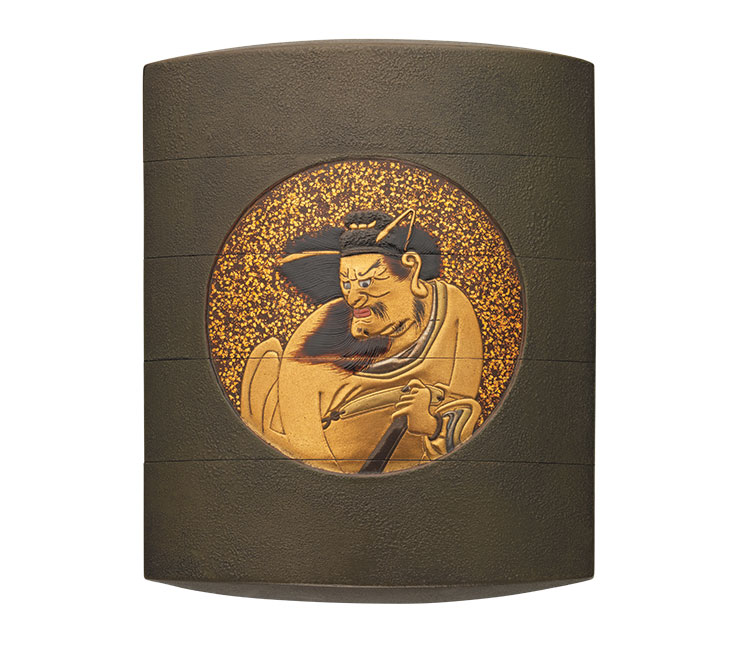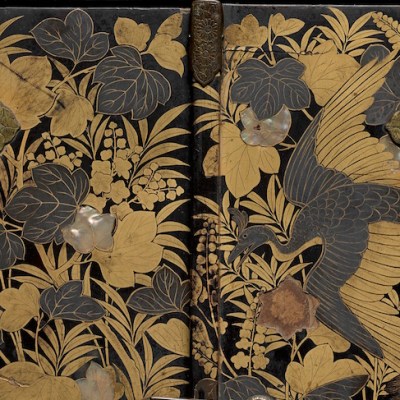The use of lacquer in Japan can be traced back to the first millennium BC, the mid to late Jomon period. The time-consuming method of covering wooden objects with urushi (derived from the sap of the tree Rhus vernicifera) to make them lustrous and durable became, over millennia, a form of high art, inspiring works of great technical brilliance and artistic refinement. In certain periods Japanese lacquer has absorbed influences from China, Korea and elsewhere in Asia, including techniques of inlaying mother-of-pearl or sheet silver and gold, and painting using lacquer mixed with powdered silver and gold. Unique to Japan, however, has been the focus on a range of techniques based on the sprinkling of metal powders over designs drawn in damp lacquer. ‘Japanese lacquer is very different from Chinese lacquer,’ explains Tsumugi Shoji of Grace Tsumugi Fine Art, a leading specialist dealer based in London. ‘It is much more than a coating or covering for wood. We have this special word, maki-e, a kind of painting, to describe the art form.’ So impressed were the first Europeans to discover this distinctive tradition that they used the word ‘Japanning’ to describe all lacquering, ushering in the first phase of extensive European collecting of objects in a tradition that continues to this day.
A work that epitomises this period is a magnificent Japanese coffer, decorated in black, gold and silver lacquer using a wide variety of techniques, with lively views and scenes from Japanese myths, including The Tale of Genji. Sold at auction in July 2013 for a then record €7.31m, this exceptional piece from the early Edo period (1615–1868) is thought to be one of ten surviving high-status pieces commissioned from the Kyoto workshop of Kaomi Nagashige by the head of the Dutch East India Company’s office in Japan. The V&A owns a smaller companion piece and had long searched for this lost treasure, once in the collection of William Beckford, but could not match the Rijksmuseum’s winning bid. Sold by Philippe Rouillac at the Château de Cheverny, it represents a peak not just of Japanese lacquer workmanship, but also of the contemporary market for lacquer. Just as in the 16th and 17th centuries, these Namban pieces – made for export to the ‘southern barbarians’ of Europe – draw plenty of interest from collectors today. ‘There is a very strong collecting base in Western Europe,’ confirms Christie’s specialist Anastasia von Seibold, who cites a late 16th-century Momoyama-period portable Christian shrine (seigan), commissioned by the Portuguese Jesuits, which fetched £386,500 in 2015 at Christie’s London.
Chest (c. 1635–45), attributed to Koami workshop. Rouillac, €7.31m Courtesy Rouillac

Tamio Ikeda of Paris’s Tanakaya gallery suggests that the art of lacquer ‘reached its apogee in the 18th century’, and that collectors both Japanese and European have also prized pieces from these earlier periods. ‘Many appreciate particularly the Rimpa [paintings] of Ogata Korin (1658–1716) or Hon’ami Koetsu (1558–1637) and their followers, with their motifs from nature,’ he says. More recently, there has been a shift in taste towards Japanese lacquer from the Meiji period (1868–1912), when the opening of Japan to the West stimulated a surge of flamboyant creativity and a new wave of collecting. The gallery has an extraordinarily fine Meiji-era chest with eight interior drawers, decorated with Shibayama lacquer and silver, inlaid with ivory, and mother-of-pearl, and signed Kougetsu.
Whereas individual artists were rarely acknowledged during the Edo period – there were schools of craftsmen working for the shogunate and noble families – during the Meiji certain individuals rose to fame. Shirayama Shosai (1853–1923) and Koda Shûetsu (1881–1933) were two, with the technically brilliant and innovative Shibata Zeshin (1807–91) highly sought-after by Western collectors. In 2014 Christie’s London sold a fine, painterly panel by Zeshin featuring lobsters, dated 1888, for £662,500. Last year the Asian Art in London (AAL) prize for Best Artwork with an Auction House was awarded to Bonhams for an atmospheric 1877 work by Zeshin, a roiro, or black lacquer panel, decorated with bell crickets on grasses bejewelled with dew drops and set against a silver lacquer moon. Estimated at £150,000–£200,000, the work was sold privately, prior to the Misumi Collection Part III auction in November 2017, for an undisclosed sum. Another Zeshin panel, with the design of a farmhouse in the snow at Sano (1883), sold in the same sale for £842,500, a record for the artist. Bonhams specialist Suzannah Yip notes that while the market for lacquer has been generally steady since its decline in the 1990s following the collapse of the Japanese economy, ‘the prices for lacquer were catapulted on to the world stage following the results witnessed from the Edward Wrangham collection, sold at Bonhams in 2010, when several pieces fetched six-figure sums.’
Suzuribako, or writing boxes, are popular objects, as are the inrō, small boxes fastened with netsuke and used to carry seals or medicines. For its AAL presentation, entitled ‘Devils, Demons and Bakemono’, Sydney L. Moss is showing an immaculate olive-green four-part inro (1880–1900), with a demon oni depicted on one side, fleeing from Shoki, the demon-queller, on the other. ‘In Japan people collect inro alongside netsuke,’ Tsumugi Shoji notes, ‘but these have been separated in the West. However, today the netsuke market is quieter while the inro market remains steady.’ At Asian Art in London she is showing a set comprising a lacquer suzuribako and a ryoshibako (document box). Dating from the Taisho period (c. 1920) and done by Koda Shûetsu (1881–1933), they are decorated in gold, silver, and red lacquer, and with Japanese flowers, plants, gulls and waves.
Four-case inro depicting the god Shoki (c. 1880–1900), Japan. Sydney L. Moss, Asian Art in London, £20,000.

London-based dealer Simon Pilling has made a speciality of the later period, 1912–44 (Taisho and early Showa), as well as contemporary examples. ‘There is a boldness and vitality that draws on a long tradition but resonates with universal contemporary values,’ he says. ‘Japanese art subjects often reflect on nature, and our relationship with the seasons. This increasingly resonates with Western clients.’ His exhibition for AAL, ‘Flora and Fable’, ‘focuses on the Japanese artistic tradition of symbolic plants’. He also has a spectacular, cosmetic box decorated with a dragon and a phoenix – ‘pure Japanese deco’ – from the Showa period, made by Isoi Joshin (1883–1964) between 1937 and 1944. In contrast to the collectors of the past, he says his younger clients are looking for outstanding single examples. With prices barely changed since Japan’s economic stagnation of the 1990s, ‘in absolute terms Japanese art is very keenly priced’, with lacquerware ‘particularly good value’.
Like Pilling, established London dealer Malcolm Fairley sources his pieces directly from Japan. At AAL he will show an unsigned, finely worked gold lacquer suzuribako with three karako (Chinese children) and a pine tree on a gold lacquer ground worked in taka-maki-e (Meiji period, c. 1890, £28,000). As is usual, the interior of the box is as beautifully worked as the exterior, with a cascading waterfall: ‘What you don’t see is as important as what you do see,’ Fairley comments.
This autumn Sotheby’s is reviving its Japanese sales after a 10-year hiatus. ‘The feeling is that the market has improved,’ says Sotheby’s consultant Mark Hinton. ‘There is a great number of collectors in Europe across Japanese prints, ceramics and lacquer. Inro have done particularly well in recent sales.’ Top lots in its November sale include a 16th-century lacquer Namban shrine from the Momoyama period (estimate £70,000–£100,000). But, Hinton says, ‘Early lacquer had its heyday in the 1970s and ’80s. Current taste prefers the spectacular pieces of the Meiji period.’ They are including a pair of elaborate gold-ground lacquer screens, featuring a whole range of techniques, from the early 20th century (estimate £500,000–£700,000). ‘There is still quite a lot of lacquer coming to the market,’ he says. Buy it while you can.
From the November 2018 issue of Apollo. Preview and subscribe here.



